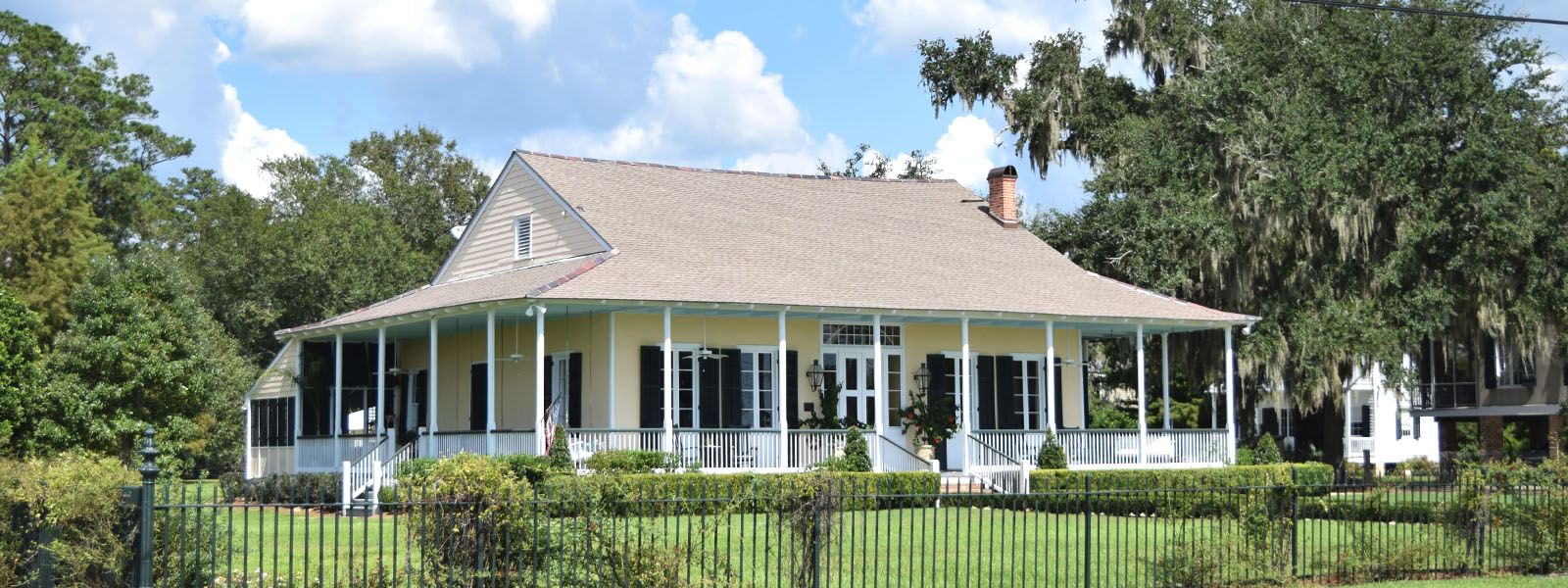Covington / Mandeville / Madisonville
Covington
Covington, at a fork of the Bogue Falaya and the Tchefuncte rivers, is the parish seat of St. Tammany Parish on the North Shore of Lake Pontchartrain from New Orleans.
Covington offers its residents not only a country living atmosphere with plenty of green space and lots of trees, but also all the shopping and dining amenities of the city. There are many upscale subdivisions here with houses available in wide price ranges. For example, a two-bedroom, two-bath, 1,159-square-foot house is for sale for $179,000. Some other offerings are a four-bedroom, three-bath, 3,600-square-foot house in Bogue Glen for $375,000 and a newly constructed five-bedroom, three-bath, 4,240-square-foot home in Natchez Trace for $849,900.
Homes here are typically one story and are surrounded by plenty of lawn and mature trees. One three-bedroom house in Pineland Acres surrounded by shade trees is on the market for just $40,000. Other houses with plenty of trees include a three-bedroom house in Country Club for $269,000 and another in Bogue Glen for $279,000.
There are also lots for sale on which you can build the home of your dreams. Two are for sale in Covington itself: one for $650,000 and another for $329,000 and another in Helenberg for $500,000.
The earliest known settlement by Europeans in the Covington area was in 1800 by Jacques Dreux. By 1813, John Wharton Collins had established a town here with the name of Wharton; Collins is buried on the corner of the city cemetery directly across from the Covington Police Department.
There are conflicting stories about how the city came to be named Covington. Many historians believe the city was renamed after GeneralLeonard Covington, a hero of the War of 1812. Another theory is that the city was named in honor of the Blue Grass whiskey – made in Covington, Kentucky and enjoyed by town officials.
Initially, commerce was brought to Covington via boat up the Bogue Falaya River, which used the Tchefuncte River as a means of passage to and from Lake Pontchartrain. In 1888, the railroad was established and much of those rails are now occupied by the Tammany Trace, a 31-mile bike trail.
In the late 20th century, with the expansion of Louisiana’s road system, many people who worked in New Orleans started living in Covington, commuting to work via the Lake Pontchartrain Causeway.
Following Hurricane Katrina in 2005, Covington experienced a population boom as former New Orleanians were forced to move out of their storm-ravaged homes, moved into the Covington area and never moved back to the city. WikiMiniAtlas
Covington has the distinction of being the home of a 10-foot-tall statue of President Ronald Reagan on a six-foot base, which is reputed to be the world’s largest statue of the former president.
The Covington Trailhead is the start of Tammany Trace, a 31-mile paved trail for hikers and bicyclists, which connects Covington with Mandeville, Abita Springs, and Lacombe, other towns in St. Tammany Parish.
If you’re looking for a country atmosphere, but with the convenience of getting to New Orleans quickly across the Causeway, Covington might just be the right place for you.
Mandeville
Mandeville is on the North Shore of Lake Pontchartrain, across the lake from New Orleans and south of Interstate 12 in St. Tammany Parish.
Mandeville is the name of two villages in Normandy, France. It means “big farm” (from Magna Villa) in medieval Norman French.
Mandeville typically offers homes on larger lots and at lower prices than those in New Orleans, yet plenty of luxury homes can also be found here. Mandeville is home to Beau Chêne, a community of homes, a 36-hole golf course, river banks and woods surrounding a country club with a fitness center, an aquatic center and three swimming pools. Beau Chêne means “Beautiful Oak” in French and is a tribute to the thousands of live oak trees dotting the landscape. Houses here are three bedrooms, two baths and range from $100,000 to $800,000.
The Sanctuary is another of Mandeville’s prestigious private communities. The residential neighborhood sits on 1,170 acres surrounded with stately pines, magnolias, oaks, and nearly 700 acres of cypress marshes and native wetland. It hosts a variety of deer, raccoons, birds, and other wildlife and is a place where children can play freely. The Health and Activity Center here offers a tournament-sized pool, three tennis courts, a children’s ball field and fitness facilities with personal trainers. Houses in The Sanctuary are three- and four-bedrooms that range from $190,000 to $1,600,000.
Mandeville had long been agricultural land when it was laid out in 1834 by developer Bernard de Marigny. It quickly became a popular summer destination for well-to-do New Orleanians wishing to escape the city’s heat.
In the mid-19th century, daily steamboat traffic between New Orleans and Mandeville began, and by the end of the Victorian era, it had become a popular weekend destination of the New Orleans middle class as well. Bands would play on the ships going across the lake and at pavilions and dance halls, and the town became one of the first places where the new jazz music was heard outside of New Orleans.
Two buildings from early jazz history still stand in Mandeville. Ruby’s Roadhouse has been in continuous operation since the 1920s and is still a popular bar and live music venue today. The Dew Drop Social and Benevolent Hall, listed on the National Register of Historic Places, opened in January 1895.
In 1956, the first span of the Lake Pontchartrain Causeway opened to automobile traffic with a second span added in 1969. The new road spurred the growth of Mandeville and the surrounding area as a suburban commuter community for people working in New Orleans. This trend increased in the 1980s and 1990s.
Mandeville is the home town of Cajun fiddler and bandleader Amanda Shaw, the rock group 12 Stones, the progressive rock band As Cities Burn, comedian Theo Von, Wilco bassist John Stirratt, and actor and environmentalist Ian Somerhalder.
MADISONVILLE
Madisonville is in St. Tammany Parish on the Northshore of Lake Pontchartrain. It has a most colorful waterfront which features outdoor dining along the Tchefuncte River estuary. Madisonville is all about water and hosts the Lake Pontchartrain Basin Maritime Museum, which puts on the Wooden Boat Festival each fall.
Madisonville offers a wide variety of houses in a wide variety of price ranges. For example, a three-bedroom, two-bath home in The Villages at Bocage is just $183,855. If you’re looking for something a little larger and more luxurious, a four-bedroom, three-bath house is available in Bedico Creek for $515,000.
Madisonville was founded by Jean Baptiste Baham in 1800, before theUnited States acquired this area, as the town of Coquille or Cokie because of the abundance of shells in the area, at the site of the Native American village of Chiconcte. The town was renamed in honor ofPresident James Madison circa 1811.
There is an historical marker next to the Tchefuncte River which includes a reference to General Andrew Jackson‘s stop here late in 1814, en route to the Battle of New Orleans. David B. Morgan and other Madisonville residents were among the American defense forces at New Orleans; several of the men are buried in the historic Madisonville Cemetery.
Madisonville was an important port, providing bricks and other products of the towns along the Tchefuncte River to New Orleans, in the decades before the Civil War. After the Unioncapture of New Orleans, this area remained under nominal Confederate control; and the cutoff of trade with New Orleans across “enemy lines” was devastating to the local economy, which did not recover for decades after the peace.
The opening of the Lake Pontchartrain Causeway and associated highways gradually brought Madisonville into the sphere of Greater New Orleans, in the second half of the 20th century.
Much of the town flooded with the Lake Pontchartrain storm surge of Hurricane Katrina, in 2005. The police station was destroyed by the flood waters, along with the lower floors of the fire station. A temporary police substation was built by a Madisonville-based company, T. Sturdevant Inc/dba Barnstormers. The ruined police station was repaired by town workers and reopened for use, while the substation was left intact and is still used as the main office of the Chief of Police.
The Lake Pontchartrain Basin Maritime Museum cooperates in research with Southeastern Louisiana University and other educational institutions here. The Tchefuncte River Lighthousewas built in 1837 and is on the National Register of Historic Places. The land route to the lighthouse was destroyed in 1965 by Hurricane Betsy, and it has since been accessible only by boat. Madisonville’s zip code is 70447.

